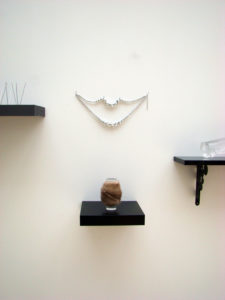In the Sensuous Void of a Volatile Collection by Sandrine Rose Schiller Hansen, Philosopher

The impossible cluster of objects in the tableau “I sense the Immortal Nobility of the Peacock’s Lust” (2013) multiplies in one self-replicating momentum. The endless strata of mirror layers repeats the volatile relation between: the luminous red gas-balloon: flimsy glass spheres: the knobbly dense root: the heart: the square: the frigid hand reaching for the hyaline sky: the walnut: stickers: jewelry: peacock feather: mirror mirroring. Out of the static order of display, in the persisting allure of the soft gleam of the peacock feather, an eclectic cacophony silently arises – the order of things is transcended and maintained like an unstable chemical compound. The passivity of position clashes with the curious interface between the objects, the agglomeration they form, and us, the audience keeping this impossible assemblage captive. Between the luscious bright objects Mia Lerssi lures us into a sensuous void where static categories melt away as amorphous solids.

In the rigid order of the static display something quirky hides beneath the luminous reflections. With the volatile order of her installations Mia inserts a wedge in our dynasty of categorization. The title of the piece “I Sense You When I Shop in The Natural Culture” (2012) reveals a point – Mia bluntly points fingers at our hopelessly archaic categorizations. The sanitized expression of this clean piece not only blurs the distinction between materials and function, also the archetypal feel of the shop window is articulated in the cool gleam of stagnated life emanating from the installation. The muted sound of clattering hooves stir in the frozen glass hoof Mia has casted from a dead horse. The same frigid elegance of stifled and tamed life radiates from the installation “I Sense The Revenge of The Dead Horse” (2013). Here the elegant glass hoof, enfolded in an air of exuberant bourgeois luxury, is dubbed by its wax double. The pair of replica horse hooves openly demonstrates the culture of manufacturing repetition and openly announces the uncanny mimicry of the natural wild in domesticated culture.

It is possible to discern two movements in Mia’s different tableaus. The first leidmotif, critically surging in the guise of the noble peacock and the dead horse is the announcement of cultural domestication and technological replication of the metamorphic nature that, contrary to the invariant mass-produced artifacts, never fully repeats itself. The second tone rising from the equivocal aggregations of glaring luster is what could be called a crystallization of cultural desire.

Before the installation “Simulacrum:murcalumiS”(2013) one is caught between two inclinations, the sensuous desire to indulge in the beautiful luscious shapes and brittle delicious surfaces, and the urge of rational thought to discover the principle of order and thus to distinguish “art” from the other cultural artifacts. Caught in an unknown space between the strong colours of consumerism and the highborn gracious art our categorizations fall short. In the piece “Soccer Ball”(2013) where three golden balls, each pertaining to different cultural realms, appears in the same contextual void, a certain aesthetic uneasiness arises from the simple fact that these objects are placed on the same conceptual plane disturbing the correct appropriation of objects. In the place of a logic, we find, especially in “Simulacrum:murcalumiS”, something weirdly confidential in the idiosyncratic rigor with which the objects have been placed relative to one another. The idiosyncrasy of collection and individuality of order resonates as an intimate and seductive invitation. Thus confronted with the crystalline desire – with cultural desire crystalized and captivated in shining glass, we catch sight of ourselves. We see the reflection of our own flimsy desire for the unattainable little object around of which we dance.

Sandrine Rose Schiller Hansen, Philosopher, 2013
